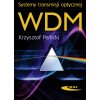- Out-of-Stock



Krzysztof Perlicki

free shipping in Poland for all orders over 500 PLN

If your payment will be credited to our account by 11:00

Each consumer can return the purchased goods within 14 days
Krzysztof Perlicki ISBN: 978-83-206-1646-0 format B5, p. 256, fig. 182, tab. 58, hardcover Price: PLN 40.00 Academic handbook on the technique of multiplication in the field of wavelength (WDM), which is one of the basic modern telecommunications techniques, enabling the implementation of very high bandwidth transmission, used in long-range systems and access networks. WDM systems architecture, physical phenomena affecting performance and abuse in WDM systems, as well as standardization and layered model as well as design and practical implementations as well as WDM systems testing methods have been described. A handbook for students of electronics, telecommunications and related fields, post-graduate students and for people who, due to their profession, have direct contact with modern telecommunications systems. Table of contents: Introduction 7
Chapter I
Introduction 9
Literature 14
Chapter II
Selected components of WDM 15 systems
2.1. Light sources 15 2.2. Optical amplifiers 20 2.2.1. Optic amplifiers doped with rare earth elements 21 2..2.2. Raman amplifiers 25 2.2.3. Semiconductor amplifiers 28 2.3. Wavelength converters 30 2.3.1. Optoelectronic converters 30 2.3.2. Purely optical converters 31 2.4. Regenerators 3R 33 2.5. Wave machines 36 2.6. Optical transfer multiplexers 41 2.7. Optical distribution boxes 43 2.8. Chromatic dispersion compensators 46 2.9. Polarizing dispersion compensators 51 2.10. Telecom optical fibers 55 References 57 Chapter III Mitigating phenomena of WDM 60 systems 3.1. Cross-channel listening 60 3.1.1. Balance of optical power of the WDM 60 system 3.1.2. Determination of crosstalk between WDM 62 channels 3.1.3. Impact of shot noise on the change in the system power balance 66 3.1.4. The effect of crosstalk on the elementary error rate level 67 3.1.5. The impact of inter-channel crosstalk on the synchronization of the telecommunications network SDH 71 3.2. Channel crosstalk 71 3.3. The influence of reflections on point inclusions in optical fiber connections 72 3.4. The phenomenon of broadcasting optical carriers 75 3.5. Non-linear phenomena in WDM 78 systems 3.6. Limited optical band 92 3.7. Chromatic and polarizing dispersion 93 3.7.1. Chromatic dispersion 94 3.7.2. Polarizing dispersion 99 3.8. Noise Amplifier 101 References 103 Chapter IV Selected Issues in the Design of WDM Systems 105 4.1. The criterion for assessing the quality of work of the optotelecommunications systems 105 4.2. Balance of optical power 109 4.3. Chromatic dispersion 114 4.4. Polarizing dispersion 122 4.5. Distribution of channels 124 4.6. Non-linear phenomena 128 4.7. Numerical modeling 130 Literature 134 Chapter V Organization of WDM systems 136 5.1. Construction of the optical transport network 136 5.2. Data transfer units 139 5.3. Headings 142 5.4. Creating an optical transport module 148 5.5. Mapping of external signals 149 5.6. IrDI and IaDI interface 151 5.7. Management 152 Literature 158 Chapter VI WDM Techniques in Telecommunications Systems 159 6.1. WDM technology in access networks 161 6.2. WDM technique in urban networks 170 6.3. WDM technology in long-distance networks 177 6.4. IP broadcast after WDM 186 Literature 198 Chapter VII Abuse in WDM 200 systems 7.1. Types of fraud 200 7.2. Unauthorized access 200 7.3. Impersonating 205 7.4. Jamming 205 7.4.1. Jamming in the band 205 7.4.2. Jamming outside the band 206 7.5. Places exposed to attacks 210 7.6. Fraud detection and elimination 213 References 214 Chapter VIII. Normalization of WDM systems 216 8.1. Normalization ETSI 216 8.2. Normalization of lEC 217 8.3. ITU Standardization 217 8.4. Documents of Telcordia 228 Chapter IX. Research on the quality of WDM systems 233 9.1. Monitoring methods 233 9.2. Measuring instruments 248 9.3. Example of monitoring system design 249 Literature 253 Important shortcuts 255
As you might have noticed, we at Ugears love the sea and marine devices inspire our creativity. If you ever wanted to sail the free waves towards the blurred line where the water blends with the sky, you will need this new sweet nautical model to help you prepare for you.
The idea behind the tugboat was to create a functional mechanism, but with a certain spice that would make it both down-to-earth and interesting. And of course – it was supposed to be a type of marine transport. UGears 70078
No product available!
No product available!
No product available!
Quadia® Tegra® K1 SOC four-core computer supporting CUDA®, RoHS technology
No product available!
No product available!
ZL2MCS51 - development kit for MCS51 microcontrollers (AT89C51RD2)
No product available!
An evaluation kit VisionSTK-NAND contains: VisionSOM-6ULL board (variant with eMMC 4 GB memory and WiFi/BT module) and VISIONCB-STD evaluation board.
No product available!
No product available!
No product available!
No product available!
No product available!
No product available!
No product available!
No product available!
eMMC Flash memory module for Hardkernel Odroid N2L computers. 64GB capacity, installed Android operating system. The set includes a microSD adapter. Hardkernel 64GB eMMC Module N2L Android
No product available!
No product available!

Krzysztof Perlicki
